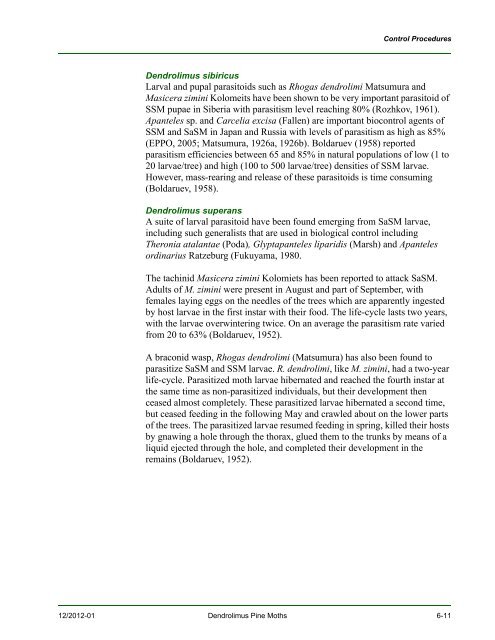New Pest Response Guidelines - aphis - US Department of Agriculture
New Pest Response Guidelines - aphis - US Department of Agriculture
New Pest Response Guidelines - aphis - US Department of Agriculture
Create successful ePaper yourself
Turn your PDF publications into a flip-book with our unique Google optimized e-Paper software.
Control Procedures<br />
Dendrolimus sibiricus<br />
Larval and pupal parasitoids such as Rhogas dendrolimi Matsumura and<br />
Masicera zimini Kolomeits have been shown to be very important parasitoid <strong>of</strong><br />
SSM pupae in Siberia with parasitism level reaching 80% (Rozhkov, 1961).<br />
Apanteles sp. and Carcelia excisa (Fallen) are important biocontrol agents <strong>of</strong><br />
SSM and SaSM in Japan and Russia with levels <strong>of</strong> parasitism as high as 85%<br />
(EPPO, 2005; Matsumura, 1926a, 1926b). Boldaruev (1958) reported<br />
parasitism efficiencies between 65 and 85% in natural populations <strong>of</strong> low (1 to<br />
20 larvae/tree) and high (100 to 500 larvae/tree) densities <strong>of</strong> SSM larvae.<br />
However, mass-rearing and release <strong>of</strong> these parasitoids is time consuming<br />
(Boldaruev, 1958).<br />
Dendrolimus superans<br />
A suite <strong>of</strong> larval parasitoid have been found emerging from SaSM larvae,<br />
including such generalists that are used in biological control including<br />
Theronia atalantae (Poda), Glyptapanteles liparidis (Marsh) and Apanteles<br />
ordinarius Ratzeburg (Fukuyama, 1980.<br />
The tachinid Masicera zimini Kolomiets has been reported to attack SaSM.<br />
Adults <strong>of</strong> M. zimini were present in August and part <strong>of</strong> September, with<br />
females laying eggs on the needles <strong>of</strong> the trees which are apparently ingested<br />
by host larvae in the first instar with their food. The life-cycle lasts two years,<br />
with the larvae overwintering twice. On an average the parasitism rate varied<br />
from 20 to 63% (Boldaruev, 1952).<br />
A braconid wasp, Rhogas dendrolimi (Matsumura) has also been found to<br />
parasitize SaSM and SSM larvae. R. dendrolimi, like M. zimini, had a two-year<br />
life-cycle. Parasitized moth larvae hibernated and reached the fourth instar at<br />
the same time as non-parasitized individuals, but their development then<br />
ceased almost completely. These parasitized larvae hibernated a second time,<br />
but ceased feeding in the following May and crawled about on the lower parts<br />
<strong>of</strong> the trees. The parasitized larvae resumed feeding in spring, killed their hosts<br />
by gnawing a hole through the thorax, glued them to the trunks by means <strong>of</strong> a<br />
liquid ejected through the hole, and completed their development in the<br />
remains (Boldaruev, 1952).<br />
12/2012-01 Dendrolimus Pine Moths 6-11

















